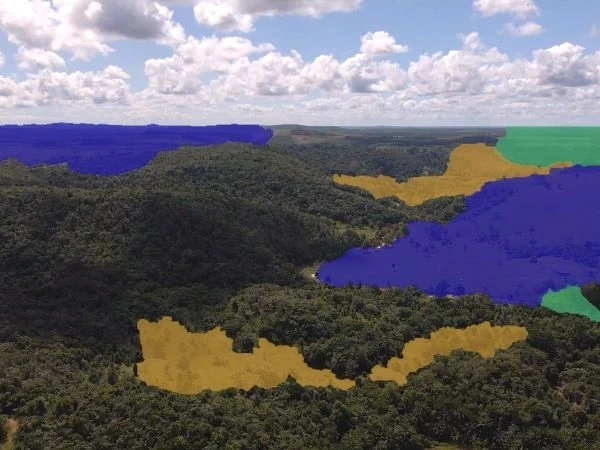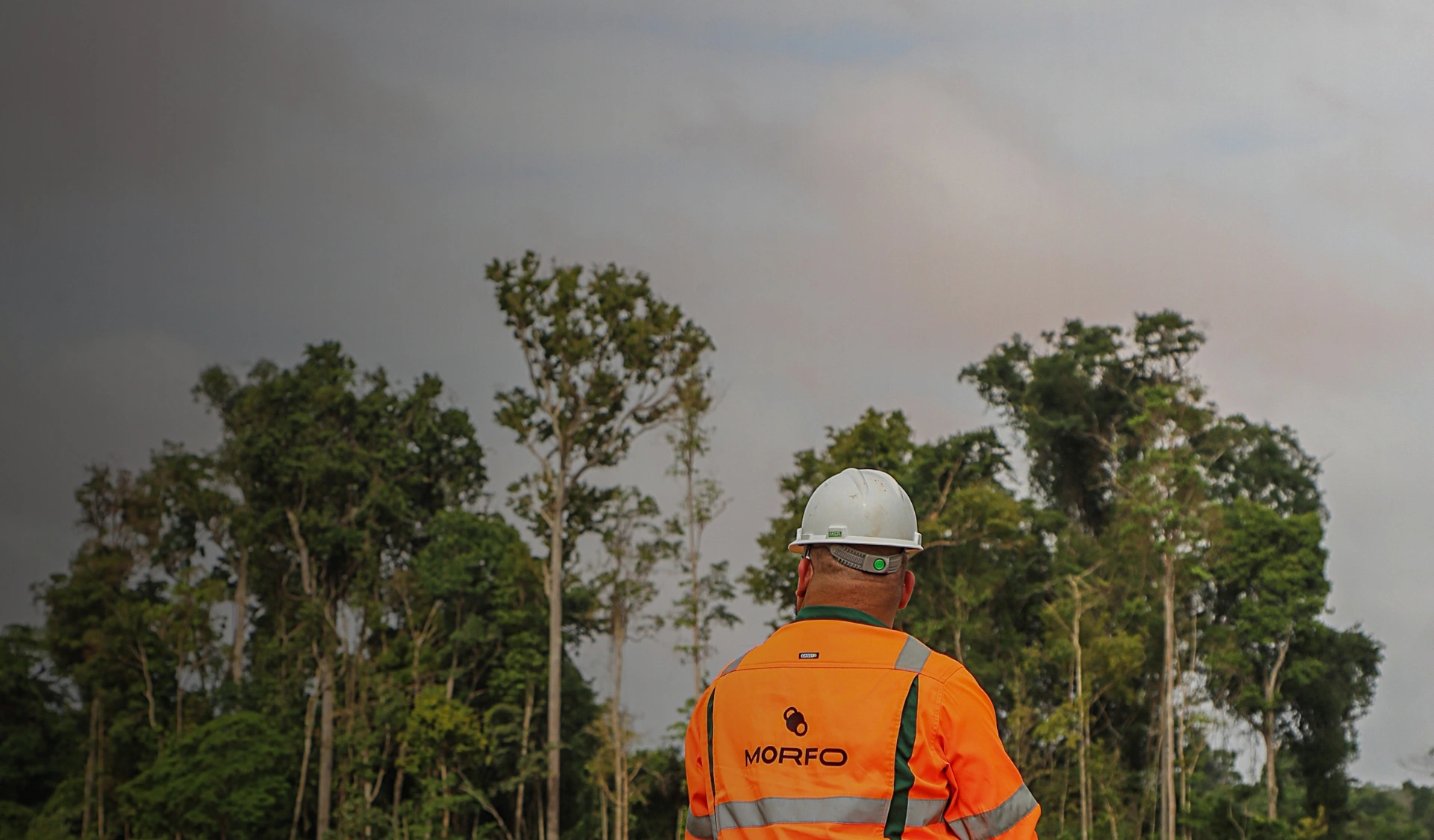There's much more to reforestation than simply planting trees. Before restoring degraded terrain, several steps are needed to understand the condition of the land and determine what and where to plant.
If the diagnosis is incomplete or inadequate, as when it is based solely on images without on-site analysis, the process is prone to numerous faults. To successfully restore a forest ecosystem, it is essential to carry out precise fieldwork, collect quality data, interpret it and study it in laboratories.
This is where MORFO stands out from other reforestation players. We offer a complete four-stage solution, enabling us to assess the areas to be restored through an in-depth diagnosis, guaranteeing more accurate and resilient restoration of complete forest ecosystems.
This article explains how MORFO carries out this diagnosis, from the first stage of forest restoration, through field analysis, to interpretation of the data, presented in detailed field condition reports.

The diagnosis phase helps to understand the site's condition
The main aim of the diagnosis phase is to assess the condition of the project sites. Not all sites are suited to the same planting approach. This is why, rather than applying generic solutions, we adjust our interventions by taking into account the specific characteristics of each location.
The land we restore is often severely degraded, with considerable biodiversity losses - both on a plant and micro-organism scale - in the soil, as well as a rugged topography with steep slopes. By identifying and diagnosing these specific problems, we are able to find the right solutions for restoration, ensuring the efficiency and sustainability of the project.
The diagnosis phase is therefore crucial for :
- Determine the steps required for effective restoration.
- Plan the planting of appropriate vegetation.
- Evaluate conditions and optimize preparation for successful planting.
- Draw up a planting plan designed to maximize the project's chances of success (adaptation to site topography, planting density, seed distribution, management of soil constraints such as pollutants or soil acidity, consideration of climatic conditions, etc.).
- Understand soil quality and logistics for planting, seed collection and drone operations.
- Lay the foundations for long-term monitoring by establishing an initial reference framework.
The diagnosis phase requires meticulous data collection to define a short- and long-term approach, integrating science, nature and technology.
"MORFO differentiates itself by adopting a "smart planting" method, which is quite distinct from conventional approaches. Tests are conducted to prove the effectiveness of these innovative methods, guaranteeing a measurable positive impact on restored ecosystems." - Adrien Pages, CEO of MORFO
MORFO's on site diagnosis method
Preparation is necessary before analyzing the terrain
Firstly, it's important to understand that MORFO complements what our customers are already doing. The first step in our diagnosis is to work with customers to gather drone data and basic field information, such as land use history.
We then identify locations for observation plots, ensuring coverage over the entire terrain. We use GPS coordinates to guide us on site and on our imagery data.

What are MORFO's reforestation operations and analyses used for?
These methodically placed observation plots allow us to:
- Document the initial route to the area, especially during the first visit with the security team and our customers.
- Carry out measurements, including soil evaluation and sampling, vegetation analysis and pest assessment.
- Install targets for drone images, providing GPS points, essential for correctly georeferenced orthophotos.
- Monitor plots over the long term, relocating them if they become inaccessible, maintaining a representation of the whole area.
We use diagnosis on field data to draw conclusions from drone images and on-site photos. We interpret the collected data to present a complete overview of the study area. Diagnosis also includes laboratory tests and analyses.
Diagnosis reports are at the origin of all forest land restoration
.png)
Reports for our customers - suitable for transmission to regulators, authorities and governments - include :
- Physical aspects such as reservoir openings, topography restoration and erosion control.
- Soil quality index, measuring proximity to the reference ecosystem*.

- Soil cover analysis, assessing health by visual assessment and plot photos.
- Segmentation of areas with vegetation types and regenerating areas for strategic actions.
- A biodiversity heat map, including the different species on each plot.

- Species identification based on field photos, recurrence and habitat preferences. We are currently developing innovative technology tools for complete species identification.
After the diagnosis: creating a planting plan adapted to the terrain
Once the diagnosis report has been drawn up using information and photos from our customers, the results of field analyses and images obtained from drones and satellites, we can move on to the next stage of MORFO's solution: the planting plan and the selection of species to be planted.In this planting plan, we vary criteria such as :
- Planting location
- Number of species to plant
- The type of species to plant
- Vegetation density

Diagnosis helps anticipate reforestation mistakes
Diagnosis processes should not be seen as additional expenses, but as investments in improved planning and better results. In reforestation projects, there is often a tendency to rush diagnosis, but this phase is crucial, and shortcutting it leads to missed savings opportunities.
Thomas Brenner, geological consultant in the mining field for 40 years, is highly regarded for his quality assurance (QA/QC), data management and mining exploration. As a key figure at CBRR, he contributed to the development of the CBRR Guide. His insight into the importance of data quality emphasizes the need for a solid foundation for reforestation:
"The financial impact of obtaining high-quality data is negligible compared with the heavy impact of using low-quality data." - Thomas Brenner, Geology and Mining Consultant
The 1-10-100 rule highlights the significant financial consequences of poor data quality. It states that costs increase by a factor of 10 if a quality problem is not detected at every stage of the chain, and postulates that prevention costs less than correction, and that correction costs less than failure.
Please note: the diagnosis may include an analysis of the social context surrounding the project area. This aspect takes into account a variety of actors, including local communities impacted by the project, those who could influence it, and those who could contribute positively to its success. By understanding social dynamics, the aim is to create a positive social impact and improve the overall success of the reforestation project.
Conclusion: MORFO stands out for its comprehensive, high-quality terrain diagnosis.
"Every day, our team works closely with our specialist partners in Brazil and France, as well as with our Data Science team, to enrich our analyses. This enables us to offer constantly evolving diagnosis reports that are highly accurate and make the most of the data. Interest in these diagnoses is growing rapidly among our customers." - Emira Cherif, Forest Ecosystems R&D Manager at MORFO
Reforestation is more than just planting trees; it requires a thoughtful approach. To conclude, here are the three key points to remember from the MORFO diagnosis:
- Understanding the terrain is crucial to successful forest replanting. Diagnosis enables us to adapt solutions to effectively restore sites, thus reducing the risk of failure.
- MORFO stands out by using a complementary approach between field analysis, drones and science. We collect detailed data and analyze it with advanced technology, guaranteeing more accurate and resilient reforestation.
- MORFO's solution starts with careful preparation, in-depth field analysis and quality data. This first step enables soil, vegetation and biodiversity to be assessed, creating detailed reports for precise forest restoration planning.
* Understand all the terms used in this article by consulting our Reforestation glossary: 100 words and expressions you need to know to work in the reforestation sector.








